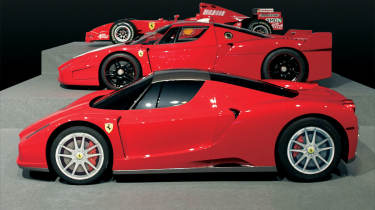The future's light
Ferrari reveals plans for its road cars: performance improvements to come from reduced size and weight, not huge power increases
It seems even Ferrari isn’t immune to concerns about the part its products play in an increasingly environmentally-aware world.
The company has been thinking long and hard about the effect future CO2 emissions regulations will have on its next generation of cars, and as part of its recent 60th birthday celebrations bosses took the unprecedented step of lifting the lid on just how it plans to face up to the conundrum of building eco-friendly supercars. And what the assembled press heard and saw was little short of revolutionary.
For example, if you thought the next Enzo-level Ferrari would be simply a road-legal development of the FXX then think again. It seems the launch of the Bugatti Veyron was the death knell for the notion of Ferrari simply producing an even more powerful version of its previous hypercar. Attempting to out-trump the mighty Bugatti was a non-starter.
Instead it was back to the drawing board to prove, as one Ferrari spokesman put it, that a two-ton car with 1000bhp is not the future. But a one-ton car with 500-600bhp? Now that might be the answer…Ferrari, it seems, thinks the biggest performance gains can be achieved by getting the best power density from its cars, and it illustrated this new drive for lightweight, efficient solutions with a number of technical displays, the centrepiece of which was the 'FXX Millechili' concept.
Looking like a cut-down Enzo, it’s not an altogether serious engineering study – the vehicle on show featured a plastic and cardboard body and paper wheels – but it demonstrated Ferrari's intent to reduce size, and therefore weight, as did its name, 'Millechili' being Italian for 1000kg, the suggested weight for such a car.
Meanwhile, away from the displays, a number of key Ferrari engineers talked us through the company's brave new vision, and they had quite a few revelations in store…
CARBONFIBRE WILL play an ever-larger part in road-going Ferraris, as the company is committed to transferring as much of its F1-derived expertise in this material to its road cars as possible. The most significant development is a new carbonfibre laminate that will be used instead of aluminium for the body panels. Lighter than aluminium, it is also a more flexible material to work with and has the added benefit of better crash characteristics.
Carbon suspension components are also on the cards, with F1-style 'flex joints' enabling wishbones to be bolted directly to the chassis, any suspension movement handled by the wishbone itself flexing rather than a conventional bush or joint (with its associated weight).
Another revelation is that the brake discs found on future Ferraris could be smaller than those fitted to today's cars thanks to the introduction of second-generation carbon-ceramic discs from Brembo. These new 'CCM-2' discs have a much higher coefficient of friction, allowing them to be smaller for the same braking power. Ferrari is also hoping that by using high-friction pads in conjunction with this new disc technology it will be able to do away with a servo, saving further weight as well as improving feel at the pedal. However, another avenue being explored is brake-by-wire technology, as this would allow the pads to be moved away from the discs electronically, improving efficiency by reducing drag on the discs when the brakes aren’t being used. Further sensors would recognise when the driver is about to brake and move the pads back close to the disc before the brake pedal is pushed.
The combination of smaller discs and less weight means that wheels and tyres can shrink in size too. As well as producing less drag, smaller tyres have a lower rolling resistance; tyre manufacturers are working on new construction techniques that could deliver a further 35 per cent saving on that front over the next five years or so.
Engine-wise, huge leaps in power aren't on the agenda, so what is? Direct injection will come with the next generation of powerplants to improve efficiency. They’ll also be able to run on bioethanol, giving another boost to performance thanks to the fuel's naturally higher octane rating.
Ferrari has looked at a number of other options, including radical supercharged two-stroke engines, turbocharging and twin-cranked engines, but it looks as if the company will continue along a conventional, normally aspirated route. The only shock, particularly for fans of traditional Ferraris, is that the V12 configuration looks under threat – its internal friction makes it inherently more thirsty than a V10 or V8.
Ferrari is also talking about hybrid powertrains on its road cars by 2012, but this has less to do with reducing emissions and more to do with increasing performance by developing a road-going version of the system F1 cars will be forced to use from the 2009 season. On its road cars Ferrari is hoping to be able to store around 100kW of energy in special batteries that are much lighter than today’s variants.
Meanwhile, instead of cutting gearshift times with a complex, DSG-style twin-clutch gearbox, Ferrari plans to use a compact, high-revving electric motor directly attached to the gearbox differential to deliver an instant slug of torque at the moment the clutch interrupts drive to the wheels, giving the driver the impression of seamless shifts. (While shift times have come down to 100ms on the 599 – and will be just 60ms on the hardcore Ferrari F430 Challenge Stradale being launched at Frankfurt this September – Ferrari can’t get this below around 30ms.)
Perhaps more immediately obvious than all these under-the-skin changes will be Ferrari's radical rethink of its cabins. Fixed seats are on the cards, and these will be in a more reclined position, along the lines of an F1 car's seat, allowing designers to use a much lower roof line (dropping by around 80mm) and add more rake to the windscreen. Different sized drivers would, of course, be accommodated by a moveable pedal box and a fully adjustable steering wheel. The steering wheel itself is set to take on a new appearance, gaining a fixed hub that will contain all the controls that would normally be housed within a conventional dashboard.
Finally, returning to the outside of the car, Ferrari has been working with Imperial College London to develop trick ‘synthetic jets’. These tiny devices, just 0.5mm in diameter, are in effect simple air valves that can be placed on strategic parts of the body. Each controlled via a tiny solenoid valve, they can dramatically affect the airflow across a car’s structure. Used in conjunction with more familiar active aerodynamics (including moveable spoilers on the underside of the car), Ferrari thinks it will see a big reduction in drag coefficients on future cars.
Summing up what all this new technology means to potential new owners, Ferrari’s general manager Amedeo Felisa reckoned the overall weight saving of 300kg the company is hoping to achieve on a production version of a car like the Millechili would consist of a 100kg saving in the construction of the body, 100kg in the repackaging of the engine and transmission, 50kg from using carbon suspension components and 50kg from the revised interior.
Felisa predicts that power will continue to increase slightly for any given engine size thanks to new technology allowing even higher revs than at present and ultra-efficient combustion control, but despite this, average CO2 figures for Ferrari's cars will drop from the current 400g/km to around 250g/km by 2012.
'Ferrari has always given its new models better performance than their predecessors, and we will continue to do so,' says Felisa, 'but future Ferraris will also be more efficient.'
In these challenging times for car makers it's reassuring to see a manufacturer like Ferrari tackle the problem head on by taking what some might call a more intelligent look at what will make a great performance car in the decade ahead.



